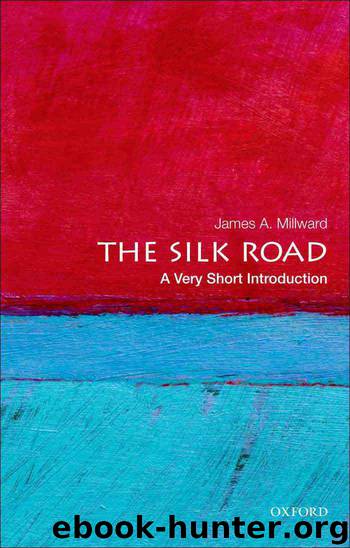The Silk Road: A Very Short Introduction (Very Short Introductions) by James A. Millward

Author:James A. Millward [Millward, James A.]
Language: eng
Format: epub
Publisher: Oxford University Press, USA
Published: 2013-03-14T16:00:00+00:00
Silk road or paper route?
Today, as newspapers become digital, millions read “the paper” on small electronic devices; these devices also help us communicate, navigate by map and compass, record and display music and images, read literature, predict astronomical events, perform mathematical calculations, learn market prices, or translate foreign languages. Anyone alive in the late twentieth century and early twenty-first century understands the transformative quality of such technology. Likewise, while silk is the most glamorous silk-road product, paper has had the most impact, since it first revolutionized most of the activities we now do with smartphones. And you can wrap fish and chips in it too.
Paper consists of vegetable fibers that have been beaten and suspended in water and dried on a screen into a felted sheet. Like many things, it was first invented in China, where credit is traditionally given to Cai Lun in the second century CE. Examples have been found, however, from as early as the first century BCE. It was probably first used to wrap things, and only later for writing on (it replaced bamboo strips and supplemented silk textiles and carved tablets for this purpose). But this flexible and strong material was also put to other uses, including as clothing, hats, shoes, armor, kites, as well as one nonliterary purpose still familiar today: a sixth-century Chinese scholar admonished his family not to use scraps of paper inscribed with the classics in the toilet—which demonstrates how inexpensive paper was by that time. (The same issue arose in China during the Cultural Revolution of the 1960s and 1970s: the ubiquity of the words of “master of the mat” Mao made it hard to put old newspapers to an accustomed purpose.)
Buddhism and the Chinese civil service examination system (which relies on candidates’ knowledge of the Chinese classics) helped spread paper use to neighboring lands. Korea and Vietnam adopted paper in the first centuries CE; a Korean monk is credited with introducing papermaking to Japan in 610. By then, paper was being made in Karakhoja (Gaochang), but archeologists, including Aurel Stein and Sven Hedin, have unearthed paper documents in Xinjiang dating from centuries earlier. Some are official or commercial records. The Soghdian letters were on paper, including the one describing the fourth-century Xiongnu attacks. Many other paper records, including the earliest printed books and other items from the Dunhuang library cave, concern Buddhism. Oddly, though Chinese missionaries brought paper to India, its use did not catch on there until the twelfth century, after Buddhism’s decline in India. Perhaps the humid climate and teeming insect life made paper too ephemeral a medium for religious texts, although later Indo-Islamic texts would indeed use paper.
The Battle of Talas, in which Tang met Arab forces in 751, is reported in a later Arabic source to have been the catalyst for the spread of paper to the Islamic world: Tha’alibi’s eleventh-century Book of Curious and Entertaining Information records that craftsmen among the Chinese taken captive in that battle opened the first paper mills in Samarkand.
Download
This site does not store any files on its server. We only index and link to content provided by other sites. Please contact the content providers to delete copyright contents if any and email us, we'll remove relevant links or contents immediately.
| Africa | Americas |
| Arctic & Antarctica | Asia |
| Australia & Oceania | Europe |
| Middle East | Russia |
| United States | World |
| Ancient Civilizations | Military |
| Historical Study & Educational Resources |
The Sympathizer by Viet Thanh Nguyen(4098)
The Rape of Nanking by Iris Chang(4025)
World without end by Ken Follett(3347)
Ants Among Elephants by Sujatha Gidla(3282)
Blood and Sand by Alex Von Tunzelmann(3061)
Japanese Design by Patricia J. Graham(3006)
City of Djinns: a year in Delhi by William Dalrymple(2438)
Foreign Devils on the Silk Road: The Search for the Lost Treasures of Central Asia by Peter Hopkirk(2389)
Inglorious Empire by Shashi Tharoor(2349)
The Queen of Nothing by Holly Black(2326)
India's Ancient Past by R.S. Sharma(2307)
In Order to Live: A North Korean Girl's Journey to Freedom by Yeonmi Park(2305)
Tokyo by Rob Goss(2295)
India's biggest cover-up by Dhar Anuj(2251)
Tokyo Geek's Guide: Manga, Anime, Gaming, Cosplay, Toys, Idols & More - The Ultimate Guide to Japan's Otaku Culture by Simone Gianni(2244)
The Great Game: On Secret Service in High Asia by Peter Hopkirk(2231)
Goodbye Madame Butterfly(2164)
Batik by Rudolf Smend(2010)
Living Silence in Burma by Christina Fink(1988)
